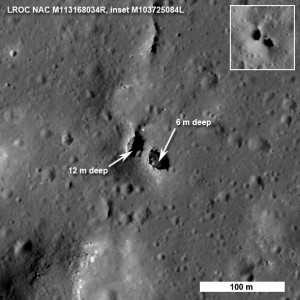(Text and image from NASA LRO website)
Just when you think you have seen everything, LROC reveals a natural bridge on the Moon! Who would have thought? Natural bridges on the Earth are typically the result of wind and water erosion — not a likely scenario on the Moon. So how did this natural bridge form? The most likely answer is dual collapse into a lava tube. From the Apollo era, SELENE, and LROC images, we know that lava tubes did form in the Moon’s ancient past. SELENE and LROC images have raised the tantalizing prospects that lava tubes remain intact to this day. However this bridge did not form in mare (basalt), but rather in impact melt from King crater! More astonishingly, the same NAC image revealed two natural bridges – not just one!

How do we know for sure that this feature is truly a bridge? Look closely at the west pit (left side) and you can see a little crescent of light on its floor. That patch of light came from the east, under the bridge. In another lower resolution image (see inset), you can see light passed under the bridge from the west. So there must be a passage. How did this oddity form? The impact melt deposit on the north rim of King crater is over 15 km across and was emplaced in a matter of minutes as the crater grew to its final configuration.